Advanced Denormalization Options for Non-relational Models
Once a model is derived, the Denormalization Wizard appears if you selected the Advanced Denormalization option on the Target Model tab. Advanced Denormalization enables you to select required objects for denormalization. It enables you to merge objects from the source model into the target NoSQL model based on your requirements.
This section walks you through the denormalization options for a Cassandra model. To denormalize models, follow these steps:
-
Open your model.
-
On the ribbon, click Action > Denormalization.
This option is supported for Amazon Keyspaces and Cassandra.
The Denormalization Wizard appears.
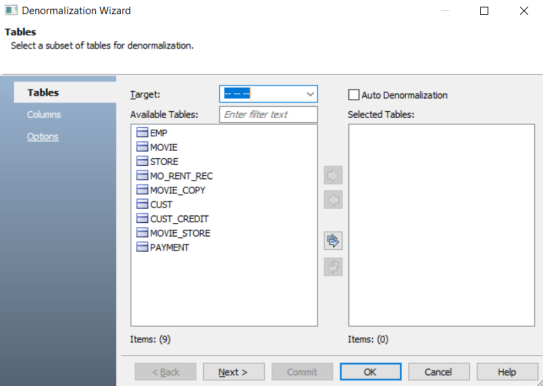
-
In the Tables section, click the Target drop-down to select a target table. All the tables will be merged into the selected target table.
Select the Auto Denormalization option to merge tables with the target automatically. This embeds the tables in the model with one-to-one relationships as User Defined Type and one-to-many relationships as normal columns. If you use this option, do not configure any options on the Columns and Options tab. Click OK.
-
Under Available Tables, select one or more tables to merge. Then, click
 .
.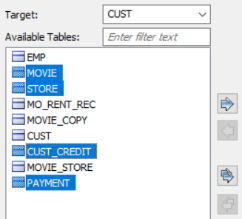
This moves the selected tables under Selected Tables.
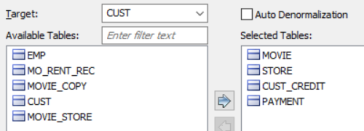
-
Click Next.
The Columns section appears. It displays a list of available columns.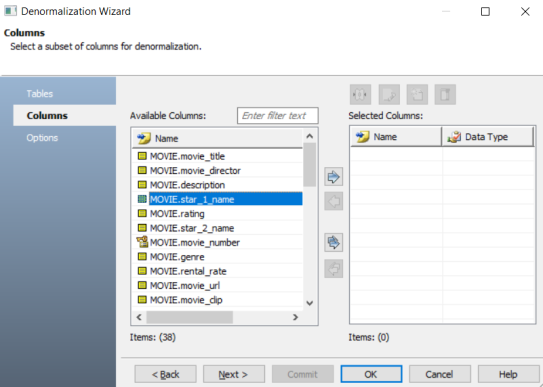
-
Under Available Columns, select the columns that you want to merge. Then, click
 .
.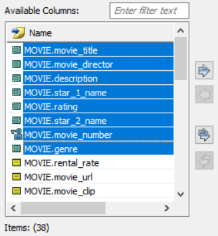
This moves the selected columns under Selected Columns section.
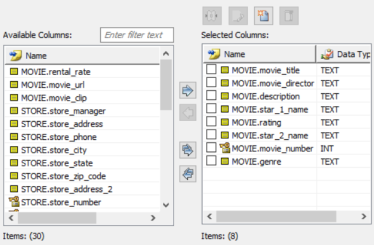
Once you have added the selected columns, you can use any of the following options:
- Merge (
 )
) -
Use this option to merge the selected columns and create a new column under Selected Columns.
- Update (
 )
) -
Use this option to edit column details such as column name, domain parent, and data type for a selected column.
- New (
 )
) -
Use this option to add a new column under Selected Columns.
- Delete (
 )
) -
Use this option to delete the selected columns.
- Merge (
-
Click Next.
The Options section appears.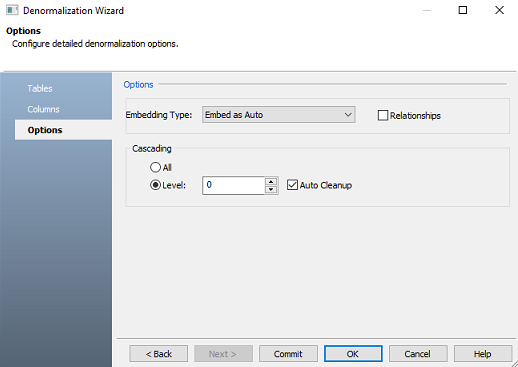
-
Select an Embedding Type.
You can select the following embedding options:
-
Embed as Auto: Use this option to embed tables through an auto-mechanism based on one-to-many and one-to-one relationships
-
One-to-many relationships are converted to normal columns.
-
One-to-one relationships are converted to User Defined Type (UDT) columns.
-
-
Embed as Normal: Use this option to embed collections using normal column styles.
-
Embed as UDT: Use this option to embed collections using UDT styles.
-
-
Select Relationships option to include table relationships to the model.
Relationships and Auto Cleanup options are mutually exclusive. As a best practice, always select only one of the options.
-
Select Cascading options to determine how multiple collections are merged into a single collection.
Use the following cascading options:-
All: Use this option to denormalize all relationship levels in a collection into a single collection.
-
Levels: Use this option to specify the number of levels up to which collections are denormalized into one collection. For example, if you set Level to 1, all the collections up to level 1 in the relationship hierarchy will be denormalized into a single collection.
-
Auto Cleanup: This option removes child collections after denormalization.
Relationships and Auto Cleanup options are mutually exclusive. As a best practice, always select only one of the options.
-
-
Click OK.
The denormalization process starts and displays objects based on selected options.
Alternatively, you can click Commit to apply changes to the model without exiting the Denormalization Wizard.
|
Copyright © 2025 Quest Software, Inc. |